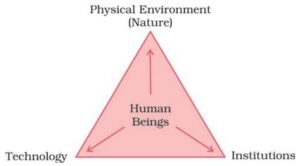Concepts
- Resource :Everything available in our environment which can be used to satisfy our needs, provided, it is technologically accessible, economically feasible and culturally acceptable can be termed as ‘Resource’.
- The process of transformation of things available in our environment involves an interactive relationship between nature,
technology and institutions. Human beings interact with nature through technology and create institutions to accelerate their
economic development.

- Natural endowments in the form of land, water, vegetation and minerals are called natural resources. Resources are materials which can be transformed in such a way that they become more valuable and useful for fulfilling human needs.
- Types of Resources : Resources are classified into various categories such as natural and human-made, renewable and non-renewable, individual, community, national and international resources.
- Natural and Human-Made or Man-Made Resources : Natural resources include land, soil, water, vegetation, wildlife, minerals and power resources. Resources created by humans are called human-made resources like engineering, technology, machines, buildings, monuments, paintings and social institutions.
- Biotic and Abiotic Resources : Resources obtained from the biosphere like forests, wildlife, fisheries, livestock, human beings, etc., which have life, are called biotic resources. Resources which are obtained from non-living things are called abiotic resources. Iron, copper, gold and lead are abiotic resources.
- Human Resources : These resources are made up of the human beings living in the world. They are the most important resource of a nation.
- Renewable and Non-Renewable Resources : Some resources have the ability to renew themselves in a given period of time. Plants and animals have the ability to regenerate. Minerals are non-renewable resources. They cannot be remade. Some of the important renewable resources are water, forests, solar, wind and tidal energy.
- Resource Development : Some natural resources cannot be used directly. While using the natural resources, we must keep in mind the nature, type and the size of the resources. Ocean water, solar energy, wind energy and climate are inexhaustible resources. Iron, tin, copper, gold and silver are exhaustible but reusable resources. We must reuse and recycle the resources.
- Resource Planning : This is a technique or skill of proper utilisation of resources.
Resource
Planning consists of three stages —- Preparation of inventory of resources — This stage includes surveying, mapping and measurement of characteristics and properties of resources.
- Evaluation in terms of availability for development — This stage includes the examination of resources from the point of view of technology, economy and need.
- Planning of exploitation of resources — This stage is related with systematic planning which emphasizes on the use and reuse of the resources. Resource planning helps to reduce wastage and keeps the environment pollution free.
- Conservation of resources — The management of resources by the humans is known as conservation. It is the judicious and planned use of the natural resources.
- Land resources — India has a variety of relief features like mountains, plateaus and plains. 43% of the country is covered by plains and they provide cultivable land for growing crops. 30% of the country is covered by mountains and they provide natural resources like forests and wildlife. 27% of the country is covered by plateaus which contain mineral resources, forests and some arable land.
- Total area of India is 3.28 million square kilometres. 44% of the total land area of India is the net sown area. 22% is covered by forests, 4% is culturable waste, 11% is fallow land, 4% are permanent pastures, 14% land is not available for cultivation and 1% is covered by miscellaneous tree crops.
- The landuse pattern in India is determined by both physical factors such as topography, climate, soil types as well as human factors such as population density, technological capability, and culture and traditions etc.
- The degradation of natural vegetation is caused by overgrazing by animals, deforestation, careless management of forests and degradation of land. At present, about 130 million hectares of degraded land exists in India.
- Soil : The uppermost layer of the earth’s crust, which is loose, fragmented and useful for plants is called soil.
- Soil Formation : The factors that contribute to the formation and fertility of the soil are parent rocks, climate, plant, animal and local topography. The soils are made out of rocks. The rocks disintegrate and decompose under the processes of weathering and erosion.
- Soil Types : The soils of India are classified into the following types —
Alluvial Soil 2 Black Soil 3 Red Soil 4 Laterite Soil 5 Mountain Soil 6 Desert Soil.- Alluvial Soil : It is of two types — khadar and bangar. It is found mainly in the Northern Plains and Coastal Strips of the Eastern Coast.
- Black Soil : It is derived from the Deccan Traps. It occurs in areas like Maharashtra, Western Madhya Pradesh and Gujarat. It is known for the cultivation of cotton.
- Red Soil : It is formed in areas of igneous and metamorphic rocks. It is found in parts of Tamil Nadu, Karnataka, Andhra Pradesh, Orissa and Jharkhand.
- Laterite Soil : It is the intensively leached soil of the monsoon climate. It is found in the hills of the Deccan, Karnataka, Kerala, Orissa and parts of Assam and Meghalaya.
- Mountain Soil : It is characterized by the deposition of organic materials derived from the vegetative cover. It is found in Meghalaya, Arunachal Pradesh, Eastern ranges, Uttarakhand, Himachal Pradesh and Jammu and Kashmir.
- Desert Soil : It is found in the arid areas of Rajasthan, Punjab and Haryana.
- Soil Erosion : The removal of soil from one place to another by some natural agent is called soil erosion. Conservation of lands and plantation of trees are the methods adopted to reduce soil erosion.

